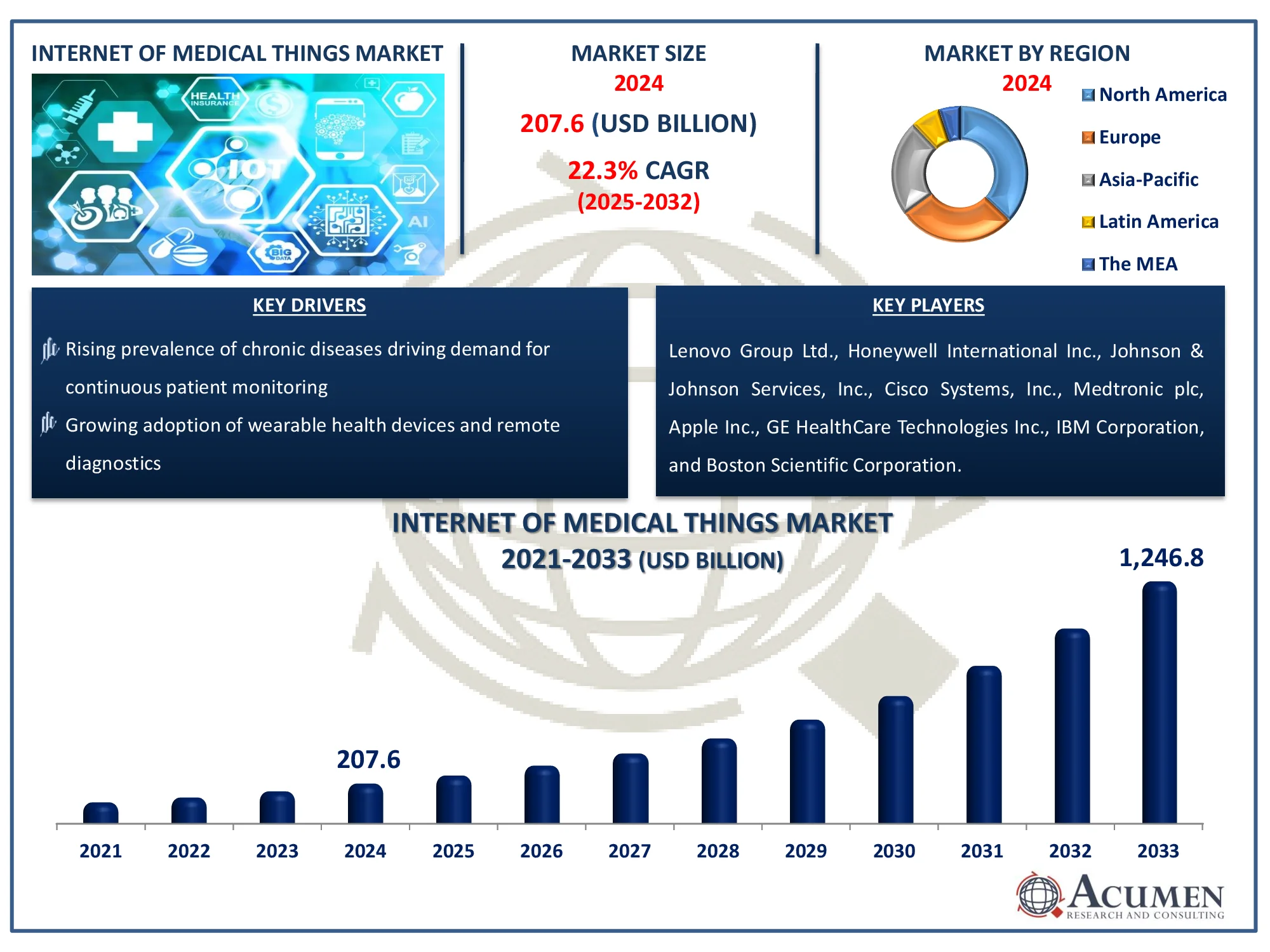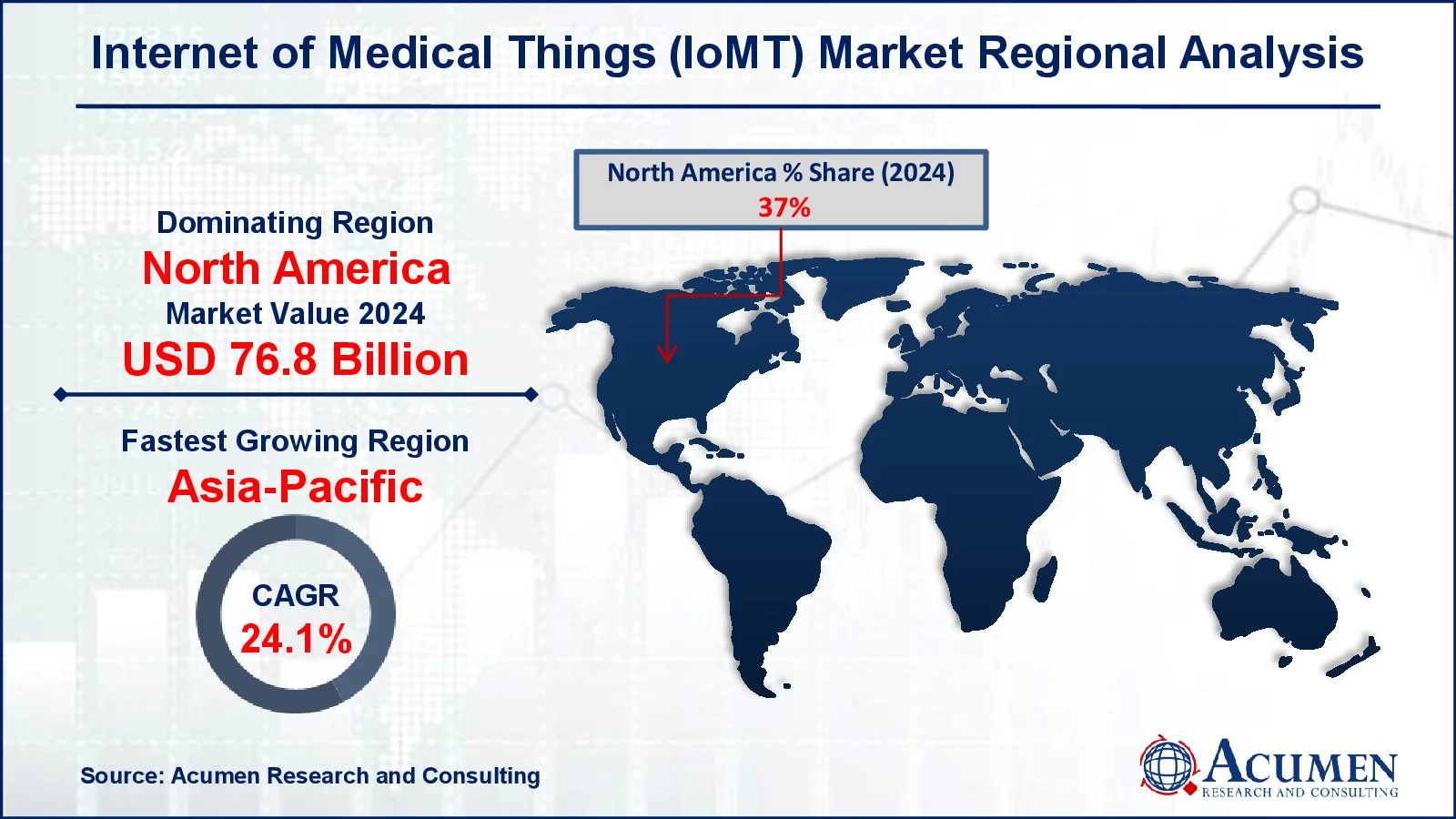July 2024
The Global Internet of Medical Things (IoMT) Market Size accounted for USD 207.6 Billion in 2024 and is estimated to achieve a market size of USD 1,246.8 Billion by 2033 growing at a CAGR of 22.3% from 2025 to 2033.
The Global Internet of Medical Things (IoMT) Market Size accounted for USD 207.6 Billion in 2024 and is estimated to achieve a market size of USD 1,246.8 Billion by 2033 growing at a CAGR of 22.3% from 2025 to 2033.

The internet of medical things (IoMT) refers to the amalgamation of medical devices and applications that can connect to healthcare information technology (IT) systems using online computer networks. IoMT is also known as healthcare IoT, where medical devices equipped with Wi-Fi allow machine-to-machine communication. IoMT devices can be linked to cloud systems like Amazon Web Services, allowing the gathered data to be saved and analyzed. These smart devices offer real-time monitoring, early diagnosis, and individualized treatment, resulting in dramatically better patient outcomes. Furthermore, IoMT facilitates remote patient care, minimizing hospital visits while improving clinical workflows and decision-making processes.
|
Market |
Internet of Medical Things (IoMT) Market |
|
Internet of Medical Things (IoMT) Market Size 2024 |
USD 207.6 Billion |
|
Internet of Medical Things (IoMT) Market Forecast 2033 |
USD 1,246.8 Billion |
|
Internet of Medical Things (IoMT) Market CAGR During 2025 - 2033 |
22.3% |
|
Internet of Medical Things (IoMT) Market Analysis Period |
2021 - 2033 |
|
Internet of Medical Things (IoMT) Market Base Year |
2024 |
|
Internet of Medical Things (IoMT) Market Forecast Data |
2025 - 2033 |
|
Segments Covered |
By Component, By Deployment, By Application, By End Use, and By Geography |
|
Regional Scope |
North America, Europe, Asia Pacific, Latin America, and Middle East & Africa |
|
Key Companies Profiled |
Lenovo Group Ltd., BIOTRONIK SE & Co. KG, Honeywell International Inc., Johnson & Johnson Services, Inc., Cisco Systems, Inc., Medtronic plc, Apple Inc., GE HealthCare Technologies Inc., IBM Corporation, Koninklijke Philips N.V., and Boston Scientific Corporation. |
|
Report Coverage |
Market Trends, Drivers, Restraints, Competitive Analysis, Player Profiling, Covid-19 Analysis, Regulation Analysis |
The increasing adoption of wearable devices and real-time healthcare service provision along with the adoption of IoMT is the factor driving the internet of medical things market growth. For instance, according to the our analysis, the wearable medical devices market size accounted for USD 23,581 million in 2021 and is predicted to be worth USD 188,398 million by 2030, with a CAGR of 26.5% during the forecasting period from 2022 to 2030.
The deduction on expenditure incurred by patients due to the less number of visits to the physician with the help of IoMT as it promotes continuous monitoring of health in individuals is additionally accelerating the market growth. Some of the other advantages associated with IoMT like real-time monitoring, reduction in medical expenditure, improved drug management, and improved patient outcomes are some of the additional factors supporting the IoMT market growth. The growing prevalence of chronic diseases is further projected to bolster internet of medical things market growth. For example, National Library of Medicine states that the global expense of chronic disease is anticipated to exceed $47 trillion by 2030. The growing technological advancement supported by start-ups and increasing demand for point-of-care medical devices by developed and developing countries is further expected to drive the growth over the forecast period from 2025 to 2033.
On the other side, the growth of the internet of medical things (IoMT) market faces certain challenges that could hinder its full potential during the forecast period. One major restraint is the high cost associated with IoT-based medical devices, which includes not only the price of the equipment but also the expenses related to installation, maintenance, and integration with existing healthcare systems. This makes it difficult for small and mid-sized healthcare facilities to adopt such technologies. Additionally, there is a significant shortage of skilled professionals who possess both medical and technical expertise necessary to operate and manage these advanced systems effectively. This lack of technical know-how can delay implementation, limit usability, and restrict the broader adoption of IoMT solutions across healthcare settings.
 Internet of Medical Things (IoMT) Market Segmentation
Internet of Medical Things (IoMT) Market SegmentationThe worldwide market for internet of medical things (IoMT) is split based on component, deployment, application, end use, and geography.
According to internet of medical things (IoMT) industry analysis, the hardware segment holds the largest share and generates maximum revenue, primarily due to the essential role physical devices play in the functioning of IoMT ecosystems. Hardware includes a broad range of medical devices such as wearable monitors, implantable devices, and stationary diagnostic equipment that are integrated with sensors and wireless communication technologies. These devices form the foundation of IoMT by capturing real-time health data, which is crucial for diagnostics, treatment, and patient monitoring.
Wearable devices, including smartwatches, fitness bands, and remote monitoring tools, are widely used for chronic disease management, especially in cases such as diabetes, cardiovascular disorders, and respiratory illnesses. The growing demand for these devices, driven by the rising emphasis on proactive and preventive healthcare, contributes significantly to hardware revenue. Implantable devices such as pacemakers and insulin pumps, equipped with IoT connectivity, are also gaining traction due to their critical role in life-saving interventions and continuous patient monitoring.
In the internet of medical things (IoMT) market, the on-premise deployment segment emerges as the prominent choice among healthcare providers, primarily due to its enhanced data control and security. On-premise solutions allow hospitals and medical institutions to store and manage sensitive patient data within their internal servers, reducing the risk of external cyber threats and data breaches. This is particularly crucial for institutions that must comply with stringent regulatory standards like HIPAA. Additionally, on-premise systems offer greater customization and integration with existing hospital IT infrastructure. While cloud deployment is gaining momentum, many large-scale healthcare organizations continue to prefer on-premise deployment for its reliability, data ownership, and ability to function without dependency on internet connectivity, ensuring uninterrupted patient care.
Telemedicine has the highest proportion of the internet of medical things industry, accounting for roughly 30%, owing to its rapid acceptance throughout healthcare systems around the world. Telemedicine uses IoMT equipment including remote monitoring tools, wearable sensors, and mobile health apps to provide virtual consultations, diagnoses, and patient follow-ups. This market experienced tremendous growth during the COVID-19 pandemic, which highlighted the necessity for remote healthcare services. The use of real-time data from IoMT devices improves the accuracy and efficiency of virtual care, minimizing hospital visits and increasing patient accessibility. Furthermore, telemedicine helps chronic disease management, mental health services, and post-operative care, which contributes to its broad use and position as the main application in the IoMT industry.
The industry's hospitals segment is expected to increase significantly between 2025 and 2033, according to the internet of medical things market prediction. This rise is being driven by the rising use of connected medical devices in hospitals for real-time patient monitoring, diagnostics, and treatment optimization. Hospitals are implementing IoMT solutions to increase workflow efficiency, eliminate manual errors, and improve patient outcomes. This trend is further supported by expanding demand for smart healthcare infrastructure, as well as increased investment in digital health technologies. Furthermore, the necessity to manage enormous patient volumes, particularly in chronic and post-operative care, is driving the use of IoMT-enabled systems in hospitals. Government actions to promote healthcare digitalization are also important in driving this segment's growth.
North America
Europe
Asia-Pacific
Latin America
The Middle East & Africa
 Internet of Medical Things (IoMT) Market Regional Analysis
Internet of Medical Things (IoMT) Market Regional AnalysisThe regional landscape of the internet of medical things (IoMT) market demonstrates various degrees of adoption and growth potential across key geographic regions, with North America leading the worldwide market. The region benefits from an established healthcare infrastructure, significant investment in digital health technology, and the presence of major industry companies such as Medtronic, GE Healthcare, and Johnson & Johnson. The United States, in particular, is seeing extensive adoption of IoMT devices due to robust regulatory frameworks, advantageous reimbursement policies, and a tech-savvy patient population.
Europe follows closely, owing to strong healthcare systems, an increased emphasis on aging populations, and supportive government efforts fostering eHealth and digital transformation in the medical sector. Germany, the United Kingdom, and France are leading the way in IoMT adoption, particularly for remote patient monitoring and telemedicine services.
Asia-Pacific is anticipated to develop the quickest between 2025 and 2033. Rising healthcare costs, greater awareness of linked health technologies, and increased smartphone and internet usage are driving market expansion in this region. China, India, and Japan are spending extensively in healthcare infrastructure upgrades and digital health technologies to meet the difficulties of huge populations and a high illness load.
Latin America, the Middle East, and Africa are rising markets with significant prospects, however growth is hampered by infrastructure restrictions and fiscal concerns. However, rising mobile penetration and international collaboration in these locations are expected to drive acceptance over time.
Some of the top internet of medical things market companies offered in our Lenovo Group Ltd., BIOTRONIK SE & Co. KG, Honeywell International Inc., Johnson & Johnson Services, Inc., Cisco Systems, Inc., Medtronic plc, Apple Inc., GE HealthCare Technologies Inc., IBM Corporation, Koninklijke Philips N.V., and Boston Scientific Corporation.
Looking for discounts, bulk pricing, or custom solutions? Contact us today at sales@acumenresearchandconsulting.com
July 2024
July 2023
June 2020
April 2023